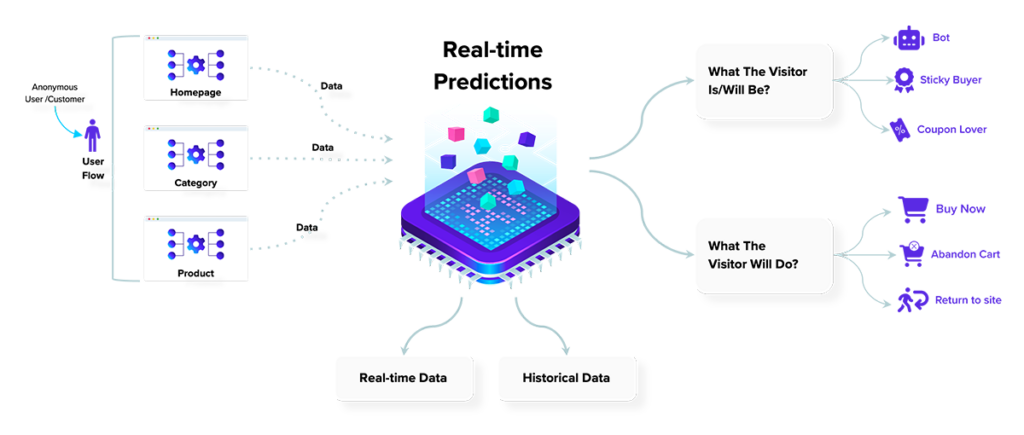The above diagram shows what happens when an anonymous user visits a site serviced by predictive analytics. First, hundreds of non-PII first-party data points combine to give a detailed picture of the user. The AI model then compares these to historical data about all other users in its database, before segmenting the user into a cohort such as ‘Coupon Lover’, ‘Sticky Buyer’, or ‘Bot’.
Predictions can then be made about what the visitor will do, based on the past behavior of the other members of this cohort. These predictions might refer to the probability of making a purchase, what product they are likely to buy, and when they are likely to abandon their cart.
How Are Different Industries Using Predictive Analytics to Stay Ahead?
The best predictive analytics systems incorporate adaptive AI models that rewrite their own code when faced with novel tasks, resulting in incredibly diverse applications for these solutions. Let’s examine how various industries are making use of this technology.
Retail
Predictive analytics enables online retailers to forecast demand, offer personalized recommendations, and optimize prices by leveraging data insights into current trends and historical patterns. Let’s look at a few examples of how this can be done:
Dynamic Pricing
Predictive algorithms analyze competitor pricing, demand forecasts, and inventory levels to dynamically adjust prices across channels. This allows these companies to optimize prices for increased sales and profit margins. For instance, during the holiday season, Walmart’s algorithm can detect rising demand for certain toys based on uptake at different stores and online. Taking into account current supply levels and competitor actions, the systems automatically make micro pricing adjustments to maximize revenue.
Personalized Recommendations
By analyzing first-party data, customer demographics, purchasing history, and other available information, retailers can provide customized product recommendations matched to shopper preferences and interests. Amazon’s recommendation algorithm is particularly advanced in this department, collecting and aggregating data on customer interactions with the site, purchases, product views, search keywords, and more to build rich shopper profiles, which are sorted into cohorts, from which recommendations can be issued.
Mobile Gaming and Applications
Predictive analytics is widely used in the online gaming industry to gain insights into player behavior and optimize games. Some key applications include:
Social Connection Tools
Most online gaming now also functions as social media, where gamers can message, voice call, make new connections, and visit user profiles. By analyzing player communication and social graph data, gaming companies can suggest new connections likely to convert to friends. For instance, Chess.com analyzes your friends, past opponents, rating, activity levels, past games, and many other things to provide match recommendations. Strengthening social bonds within games boosts engagement and retention.
Increasing Customer Lifetime Value (LTV)
Games and other mobile apps are often monetized by in-app purchases such as premium subscriptions, extra ‘lives’, and other bonuses. Predictive AI models can identify the users, moments, and incentives that are most likely to lead to a purchase. This is particularly prominent in casino apps, where players can buy extra bets and spins through in-app purchases. Predictive AI analyzes player behavior to strategically offer tempting deals, maximizing revenue for site owners.
Adtech: Ad Targeting
An early adopter of predictive analytics, a changing regulatory landscape defined by GDPR, CCPA, and the demise of third-party cookies is now forcing advertisers to rethink their methods.
The advertising industry has long used AI to better tailor ads to consumers. With the decline of third-party data, effective algorithmic decisions will need to be made based on more limited datasets. Fortunately, the advancement of advertisements using first-party data has accelerated rapidly. Digital advertising space on Amazon and Walmart now harnesses first-party data, such as the device and browser a visitor uses, their purchasing history, and hundreds of other data points, to recommend targeted adverts.
Publishing: Content Recommendations
Predictive analytics drives the publishing industry by enabling companies to match content to individual reader interests to maximize engagement.
Major publishing platforms like The New York Times analyze which articles individual subscribers read, share and the topics that interest them. Powerful recommendation engines then serve readers customized suggestions on undiscovered content most aligned to their tastes and reading history, keeping them engaged longer and driving subscription renewals.
Fintech: Fraud Detection and Risk Monitoring
Predictive analytics enables fintech companies to quantify risks precisely, personalize intelligently, and scale sustainably by leveraging data-based forecasts and insights.
Just as users can be segmented into cohorts that reveal their spending habits, they can also be placed within cohorts that suggest they’re up to no good. Cyber security experts and risk analysts use machine learning to process customer transactions, spending patterns, locations, networks, and other attributes. This allows them to detect and predict anomalous behaviors indicative of fraud, money laundering, or cyber threats, potentially saving companies millions of dollars in averted theft.
The possibilities are endless
These are just a few examples of the hundreds of industries where predictive analytics have become indispensable assets, facilitating nuanced approaches to individual users in a way that was previously thought impossible. Given the seemingly infinite capacity of adaptive AI-powered predictive analytics to mold themselves to diverse tasks, their range of applications is likely to expand exponentially as site owners continue to realize their potential. What is certain is that the companies that become the losers of this AI arms race will also lose out on huge profits in the months and years to come.



